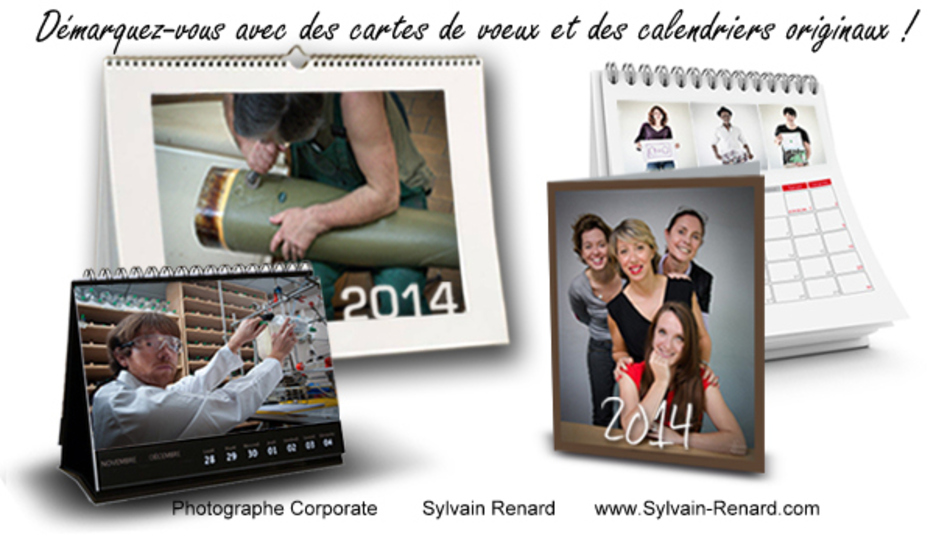
Differentiate your company through original corporate greeting cards and calendars
Follow the advice of a Corporate photographer, Sylvain Renard, to produce successful greeting cards and calendars
Now here’s a topic that comes up time and again
The date is not a problem…
… but do you know exactly when to send them out and to whom?
Do you know the steps to successfully manage an original greeting card or corporate photo calendar project?
For those who don’t, it can turn into a real nightmare
In the following article I’m going to try to make it less of an ordeal with a few suggestions to make your greeting cards not only a real communication tool enabling you to stand out from the competition, but even a real pleasure for all.
For the curious among you, at the end of the article you’ll find the history of the origins of greeting cards and their development through the ages.
When to send cards?
Depending on the country, greeting cards are sent out at different times.
According to tradition, in France, you can send Christmas cards from the beginning of December, and New Year cards until the end of January.
This may well surprise many of our European neighbours, especially our Anglo-Saxon friends, who without fail always send them off before Christmas.
This means it’s better to plan ahead if you want to have enough time to prepare everything properly.
Who do we send cards to?
In the business world, greeting cards and calendars show our clients, potential clients and business relations how much we value them. It’s also a good way to strengthen existing relationships and, above all, to stand out from our competitors.
Print remains an effective communication tool if it’s well designed.
The emails we receive are soon forgotten while an original card with a personal message or an ingenious calendar will find a place on our desk.
You know this from your own experience.
How to design original greeting cards or photo calendars?
Below are a few ideas depending on your budget and the goals you have in mind:
On the one hand, the greeting card with an original photo illustrates your world, a message you want to put across, or a passion you want to share.
On the other hand, the calendar fulfils several objectives over and above the traditional ones, as it can be used to promote your staff, your teams, your products or your know-how. Sitting on a desk or pinned to the wall for 365 days of the year in a company, it’s a practical and cost-effective way to communicate with your business relations and clients so that you’re never far from their mind during the calendar year.
The four steps to successfully manage a greeting card or photo calendar project:
1-You know more or less what your project involves (who you want to send cards or calendars to, a potential theme, a budget, even if it’s still a bit vague, the approximate number of cards/calendars…)
2-We meet to work together on your project to give it more sense and more clout, to find the best idea and define a plan.
3- The photographic session/shoot
If you want to highlight the people side of your business by taking photos of your staff, this can also be an opportunity to strengthen the team spirit and to create bonds between the different departments as they share this unique experience. It’s therefore an original team-building exercise as well as an efficient management tool to round off the end of the year in style. It can serve as an opportunity to create a company organisation chart.
4-Post production / Printing – Copies
A few weeks later, you will receive the photo calendars and greeting cards ready for distribution.
For more information: Contact me
And finally, where does the greeting card tradition come from?
The custom of greeting cards originated in the Far East around the 5th century AD.
People would send cards made of rice paper at the beginning of the year. The more important the person receiving the card, the bigger the sheet of rice paper would be.
And in Europe?
In the Middle Ages, nuns would send their compliments and a small gift to their families, together with a hand-painted card.
In France, it was customary to visit one’s entourage during the first half of January. This tradition still survives today and is called ‘les etrennes’ (the New Year collection box for tips).
To avoid discussion, it was normal practice to leave a visiting card as evidence of one’s passing.
In the 15th century, it became the custom to send greetings to give news to family and friends and to keep up friendships.
With the arrival of the postage stamp in England in 1840, the custom of sending Christmas cards spread across Europe.



